Baltimore, Maryland 作者: 来源: 发布时间:2021-11-08
I.Population and Area
₋Area
Land: 80.95 sq mi (209.65 km2)
₋Population
Total: 620,961
Density: 7,556.25/sq mi (2,917.48/km2)
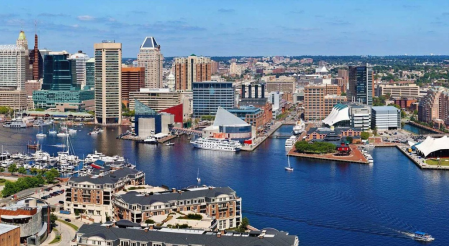
II.Natural Geography
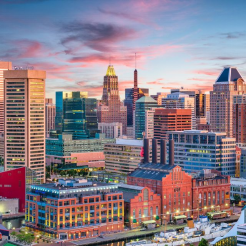
Downtown View
₋Baltimore (/ˈbɔːltɪmɔːr/ BAWL-tim-or, locally: /ˈbɔːlmər/) is the most populous city in the U.S. state of Maryland, as well as the 30th most populous city in the United States, with a population of 593,490 in 2019. Baltimore is the largest independent city in the country and was established by the Constitution of Maryland in 1851. As of 2017, the population of the Baltimore metropolitan area was estimated to be just under 2.802 million, making it the 21st largest metropolitan area in the country. Baltimore is located about 40 miles (64 km) northeast of Washington, D.C., making it a principal city in the Washington-Baltimore combined statistical area (CSA), the fourth-largest CSA in the nation, with a calculated 2018 population of 9,797,063.
₋The city's Inner Harbor was once the second leading port of entry for immigrants to the United States. In addition, Baltimore was a major manufacturing center. After a decline in major manufacturing, heavy industry, and restructuring of the rail industry, Baltimore has shifted to a service-oriented economy. Johns Hopkins Hospital (founded 1889), Johns Hopkins Children's Center, and Johns Hopkins University (founded 1876) are the city's top two employers.
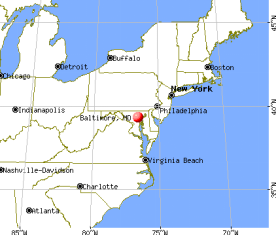
₋With hundreds of identified districts, Baltimore has been dubbed a "city of neighborhoods." Famous residents have included writers Edgar Allan Poe, Edith Hamilton, Frederick Douglass, W.E.B. Du Bois, Ogden Nash, Gertrude Stein, F. Scott Fitzgerald, Dashiell Hammett, Upton Sinclair, Tom Clancy, Ta-Nehisi Coates, and H. L. Mencken; musicians James "Eubie" Blake, Billie Holiday, Cab Calloway, Tori Amos, Frank Zappa, Tupac Shakur, Dan Deacon, Robb ie Basho, Bill Frisell, Philip Glass, Cass Elliot, and Ric Ocasek; actors and filmmakers John Waters, Barry Levinson, Divine, David Hasselhoff, Don Messick, John Kassir, Jada Pinkett Smith, Edith Massey and Mo'Nique; artist Jeff Koons; baseball player Babe Ruth; swimmer Michael Phelps; radio host Ira Glass; television host Mike Rowe; Supreme Court Justice Thurgood Marshall; Speaker of the United States House of Representatives Nancy Pelosi; and United States Secretary of Housing and Urban Development Ben Carson. During the War of 1812, Francis Scott Key wrote "The Star-Spangled Banner" in Baltimore after the bombardment of Fort McHenry. His poem was set to music and popularized as a song; in 1931 it was designated as the American national anthem.
₋Baltimore has more public statues and monuments per capita than any other city in the country, and is home to some of the earliest National Register Historic Districts in the nation, including Fell's Point, Federal Hill, and Mount Vernon. These were added to the National Register between 1969 and 1971, soon after historic preservation legislation was passed. Nearly one third of the city's buildings (over 65,000) are designated as historic in the National Register, which is more than any other U.S. city.
III.ECONOMY
₋The average salary in Baltimore, MD is $66k. Trends in wages increased by 0.2 percent in Q1 2020. The cost of living in Baltimore, MD is 17 percent higher than the national average. The most popular occupations in Baltimore, MD are Software Engineer, Project Manager, (Unspecified Type / General), and Operations Manager which pay between $40k and $120k per year. The most popular employers in Baltimore, MD are Johns Hopkins University, Northrop Grumman Corporation, and Under Armour, Inc..
₋Website: https://www.payscale.com/research/US/Location=Baltimore-MD/Salary
IV.Industrial Characteristics
₋Once a predominantly industrial town, with an economic base focused on steel processing, shipping, auto manufacturing (General Motors Baltimore Assembly), and transportation, the city experienced deindustrialization which cost residents tens of thousands of low-skill, high-wage jobs. The city now relies on a low-wage service economy, which accounts for 31% of jobs in the city. Around the turn of the 20th century, Baltimore was the leading US manufacturer of rye whiskey and straw hats. It also led in refining of crude oil, brought to the city by pipeline from Pennsylvania.
₋As of March 2018 the U.S. Bureau of Labor Statistics calculates Baltimore's unemployment rate at 5.8% while one quarter of Baltimore residents (and 37% of Baltimore children) live in poverty. The 2012 closure of a major steel plant at Sparrows Point is expected to have a further impact on employment and the local economy. The Census Bureau reported in 2013 that 207,000 workers commute into Baltimore city each day. Downtown Baltimore is the primary economic asset within Baltimore City and the region with 29.1 million square feet of office space. The tech sector is rapidly growing as the Baltimore metro ranks 8th in the CBRE Tech Talent Report among 50 U.S. metro areas for high growth rate and number of tech professionals. Forbes ranked Baltimore fourth among America's "new tech hot spots".
V.Attractions
1.Baltimore Aquarium
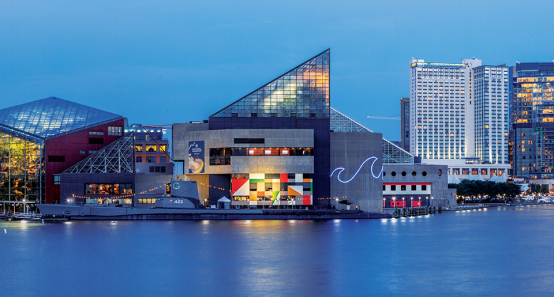
₋The National Aquarium - also known as National Aquarium in Baltimore and formerly known as Baltimore Aquarium - is a non-profit public aquarium located at 501 East Pratt Street on Pier 3 in the Inner Harbor area of downtown Baltimore, Maryland, in the United States. Constructed during a period of urban renewal in Baltimore, the aquarium opened on August 8, 1981. The aquarium has an annual attendance of 1.5 million visitors and is the largest tourism attraction in the State of Maryland. The aquarium holds more than 2,200,000 US gallons (8,300,000 l) of water, and has more than 17,000 specimens representing over 750 species. The National Aquarium's mission is to inspire conservation of the world's aquatic treasures. The aquarium's stated vision is to confront pressing issues facing global aquatic habitats through pioneering science, conservation, and educational programming.
₋The National Aquarium houses several exhibits including the Upland Tropical Rain Forest, a multiple-story Atlantic Coral Reef, an open ocean shark tank, and Australia: Wild Extremes, which won the "Best Exhibit" award from the Association of Zoos and Aquariums in 2008. The aquarium also has a 4D Immersion Theater. The aquarium opened a marine mammal pavilion on the adjacent south end of Pier 4 in 1990, and currently holds six Atlantic bottlenose dolphins. Of the six, five were born at the National Aquarium, one was born at another American aquarium.
₋In 2003, the National Aquarium and the much older and independent National Aquarium in Washington, D.C., formed an alliance to operate as a single National Aquarium with two sites. This arrangement continued until 2013, when the Washington location closed permanently.
₋Address: 501 E Pratt St, Baltimore, MD 21202, United States
₋Website: https://aqua.org/
2.Baltimore Museum of Art
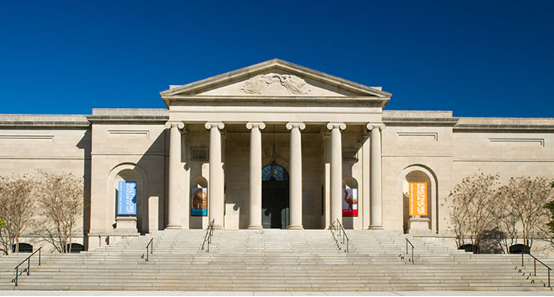
₋The Baltimore Museum of Art (BMA) in Baltimore, Maryland, United States, is an art museum that was founded in 1914. The BMA's internationally renowned collection of 95,000 objects encompasses more than 1,000 works by Henri Matisse anchored by the Cone Collection of modern art, as well as one of the nation's finest holdings of prints, drawings, and photographs. The galleries currently showcase collections of art from Africa; works by established and emerging contemporary artists; European and American paintings, sculpture, and decorative arts; ancient Antioch mosaics; art from Asia, and textiles from around the world.
₋The 210,000-square-foot (20,000 m2) museum is distinguished by a neoclassical building designed in the 1920s by renowned American architect John Russell Pope and two landscaped gardens with 20th-century sculpture. The museum is located between Charles Village, to the east, Remington, to the south, Hampden, to the west; and south of the Roland Park neighborhoods, immediately adjacent to the Homewood campus of Johns Hopkins University, though the museum is an independent institution and not affiliated with the university.
₋The highlight of the museum is the Cone Collection, brought together by Baltimore sisters Claribel (1864–1929) and Etta Cone (1870–1949). Accomplished collectors, the sisters amassed a wealth of works by artists including Henri Matisse, Pablo Picasso, Paul Cézanne, Edgar Degas, Paul Gauguin, Vincent van Gogh, and Pierre-August Renoir, nearly all of which were donated to the museum. The museum is also home to 18,000 works of French mid-19th-century art from the George A. Lucas collection, which has been acclaimed by the museum as a cultural "treasure" and "among the greatest single holdings of French art in the country."
₋The BMA is currently led by Director Christopher Bedford, who was appointed in May 2016, after a year-long search. Prior to joining the BMA, Bedford led the Rose Art Museum at Brandeis University in Massachusetts for four years. He helped the Rose Art Museum out of the international controversy from 2009, when the university proposed selling off the museum's top-notch art collection to help with its struggling finances.
₋In November 2019, it was announced that the Baltimore Museum of Art will only purchase works made by female-identifying artists in 2020. The decision was made in efforts to work towards “re-correcting the canon.” To also mark the 100th anniversary of 19th amendment in 2020, all 22 exhibitions planned for the museum that year will be focused on women artists.
₋Since October 2006, The Baltimore Museum of Art and the Walters Art Museum (formerly Walters Art Gallery), have offered free general admission year-round as a result of grants given by Baltimore City, Baltimore County, and several foundations.
₋The Baltimore Museum of Art is the site of Gertrude's Chesapeake Kitchen, owned and operated by chef John Shields.
₋Located in: Johns Hopkins University
₋Address: 10 Art Museum Dr, Baltimore, MD 21218, United States
₋Website: https://artbma.org/
3.Fort McHenry
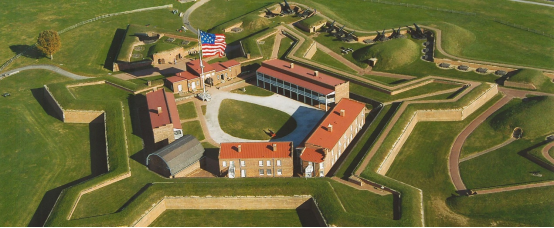
₋Fort McHenry is a historical American coastal pentagonal bastion fort located in the Locust Point neighborhood of Baltimore, Maryland. It is best known for its role in the War of 1812, when it successfully defended Baltimore Harbor from an attack by the British navy from the Chesapeake Bay on September 13–14, 1814. It was first built in 1798 and was used continuously by the U.S. armed forces through World War I and by the Coast Guard in World War II. It was designated a national park in 1925, and in 1939 was redesignated a "National Monument and Historic Shrine".
₋During the War of 1812 an American storm flag, 17 by 25 feet (5.2 m × 7.6 m), was flown over Fort McHenry during the bombardment. It was replaced early on the morning of September 14, 1814 with a larger American garrison flag, 30 by 42 feet (9.1 m × 12.8 m). The larger flag signaled American victory over the British in the Battle of Baltimore. The sight of the ensign inspired Francis Scott Key to write the poem "Defence of Fort M'Henry" that was later set to the tune "To Anacreon in Heaven" and became known as "The Star Spangled Banner", the national anthem of the United States.
₋Address: 2400 E Fort Ave, Baltimore, MD 21230, United States
₋Established: March 3, 1925
₋Website: https://www.nps.gov/fomc/index.htm
VI.History
₋Before European settlement
₋The Baltimore area had been inhabited by Native Americans since at least the 10th millennium BC, when Paleo-Indians first settled in the region. One Paleo-Indian site and several Archaic period and Woodland period archaeological sites have been identified in Baltimore, including four from the Late Woodland period. During the Late Woodland period, the archaeological culture that is called the "Potomac Creek complex" resided in the area from Baltimore south to the Rappahannock River in present-day Virginia.
₋In the early 1600s, the immediate Baltimore vicinity was sparsely populated, if at all, by Native Americans. The Baltimore County area northward was used as hunting grounds by the Susquehannock living in the lower Susquehanna River valley. This Iroquoian-speaking people "controlled all of the upper tributaries of the Chesapeake" but "refrained from much contact with Powhatan in the Potomac region" and south into Virginia. Pressured by the Susquehannock, the Piscataway tribe, an Algonquian-speaking people, stayed well south of the Baltimore area and inhabited primarily the north bank of the Potomac River in what are now Charles and southern Prince George's counties in the coastal areas south of the Fall Line.
₋Colonial period
₋European colonization of Maryland began with the arrival of an English ship at St. Clement's Island in the Potomac River on March 25, 1634. Europeans began to settle the area further north, beginning to populate the area of Baltimore County. The original county seat, known today as "Old Baltimore", was located on Bush River within the present-day Aberdeen Proving Ground. The colonists engaged in sporadic warfare with the Susquehanna, whose numbers dwindled primarily from new infectious diseases, such as smallpox, endemic among the Europeans. In 1661 David Jones claimed the area known today as Jonestown on the east bank of the Jones Falls stream.
₋The colonial General Assembly of Maryland created the Port of Baltimore at old Whetstone Point (now Locust Point) in 1706 for the tobacco trade. The Town of Baltimore, on the west side of the Jones Falls, was founded and laid out on July 30, 1729. By 1752 the town had just 27 homes, including a church and two taverns. Jonestown and Fells Point had been settled to the east. The three settlements, covering 60 acres (24 ha), became a commercial hub, and in 1768 were designated as the county seat.
₋Being a colony, the Baltimore street names were laid out to demonstrate loyalty to the mother country. For example, King George, King, Queen, and Caroline streets.
₋Baltimore grew swiftly in the 18th century, its plantations producing grain and tobacco for sugar-producing colonies in the Caribbean. The profit from sugar encouraged the cultivation of cane in the Caribbean and the importation of food by planters there. As noted, Baltimore was as the county seat, and in 1768 a courthouse was built to serve both the city and county. Its square was a center of community meetings and discussions.
₋Baltimore established its public market system in 1763. Lexington Market, founded in 1782, is known as one of the oldest continuously operating public markets in the United States today. Lexington Market was also a center of slave trading. Slaves were sold at numerous sites through the downtown area, with sales advertised in the Baltimore Sun. Both tobacco and sugar cane were labor-intensive crops.
₋Baltimore in 1774 established the first Post Office system in what became the United States, and the first water company chartered in the newly independent nation (Baltimore Water Company, 1792).
₋Baltimore played a key part in events leading to and including the American Revolution. City leaders such as Jonathan Plowman Jr. led many residents in joining the resistance to British taxes, and merchants signed agreements to refuse to trade with Britain. The Second Continental Congress met in the Henry Fite House from December 1776 to February 1777, effectively making the city the capital of the United States during this period.
₋Antebellum period
₋The Town of Baltimore, Jonestown, and Fells Point were incorporated as the City of Baltimore in 1796–1797. The city remained a part of surrounding Baltimore County and continued to serve as its county seat from 1768 to 1851, after which it became an independent city.
₋The Battle of Baltimore against the British in 1814 inspired the composition of the USA's national anthem, "The Star-Spangled Banner," and the construction of the Battle Monument which became the city's official emblem. A distinctive local culture started to take shape, and a unique skyline peppered with churches and monuments developed. Baltimore acquired its moniker "The Monumental City" after an 1827 visit to Baltimore by President John Quincy Adams. At an evening function Adams gave the following toast: "Baltimore: the Monumental City—May the days of her safety be as prosperous and happy, as the days of her dangers have been trying and triumphant."
₋Baltimore pioneered the use of gas lighting in 1816, and its population grew rapidly in the following decades, with concomitant development of culture and infrastructure. The construction of the federally funded National Road (which later became part of U.S. Route 40) and the private Baltimore and Ohio Railroad (B. & O.) made Baltimore a major shipping and manufacturing center by linking the city with major markets in the Midwest. By 1820 its population had reached 60,000, and its economy had shifted from its base in tobacco plantations to sawmilling, shipbuilding, and textile production. These industries benefited from war but successfully shifted into infrastructure development during peacetime.
₋Baltimore suffered one of the worst riots of the antebellum South in 1835, when bad investments led to the Baltimore bank riot. Soon after the city created the world's first dental college, the Baltimore College of Dental Surgery, in 1840, and shared in the world's first telegraph line, between Baltimore and Washington DC in 1844.
₋Maryland, a slave state with abundant popular support for secession in some areas, remained part of the Union during the American Civil War, due in part to the Union's strategic occupation of the city in 1861. Another factor was the fact that the Union's capitol, Washington, was in the state of Maryland (geographically if not politically), and well situated to impede Baltimore and Maryland's communication or commerce with the Confederacy. Baltimore saw the first casualties of the war on April 19, 1861, when Union Soldiers en route from the President Street Station to Camden Yards clashed with a secessionist mob in the Pratt Street riot.
₋In the midst of the Long Depression which followed the Panic of 1873, the Baltimore & Ohio Railroad company attempted to lower its workers' wages, leading to strikes and riots in the city and beyond. Strikers clashed with the National Guard, leaving 10 dead and 25 wounded.
₋20th century through 1968
₋On February 7, 1904, the Great Baltimore Fire destroyed over 1,500 buildings in 30 hours, leaving more than 70 blocks of the downtown area burned to the ground. Damages were estimated at $150 million—in 1904 dollars. As the city rebuilt during the next two years, lessons learned from the fire led to improvements in firefighting equipment standards.
₋Baltimore lawyer Milton Dashiell advocated for an ordinance to bar African-Americans from moving into the Eutaw Place neighborhood in northwest Baltimore. He proposed to recognize majority white residential blocks and majority black residential blocks, and to prevent people from moving into housing on such blocks where they would be a minority. The Baltimore Council passed the ordinance, and it became law on December 20, 1910, with Democratic Mayor J. Barry Mahool's signature The Baltimore segregation ordinance was the first of its kind in the United States. Many other southern cities followed with their own segregation ordinances, though the US Supreme Court ruled against them in Buchanan v. Warley (1917).
₋The city grew in area by annexing new suburbs from the surrounding counties through 1918, when the city acquired portions of Baltimore County and Anne Arundel County. A state constitutional amendment, approved in 1948, required a special vote of the citizens in any proposed annexation area, effectively preventing any future expansion of the city's boundaries. Streetcars enabled the development of distant neighborhoods areas such as Edmonson Village whose residents could easily commute to work downtown.
₋Driven by migration from the deep South and by white suburbanization, the relative size of the city's black population grew from 23.8% in 1950 to 46.4% in 1970. Encouraged by real estate blockbusting techniques, recently settled white areas rapidly became all-black neighborhoods, in a rapid process which was nearly total by 1970.
₋1968 and after
₋The Baltimore riot of 1968, coinciding with riots in other cities, followed the assassination of Martin Luther King, Jr. on April 4, 1968. Public order was not restored until April 12, 1968. The Baltimore riot cost the city an estimated $10 million (US$ 74 million in 2020). A total of 11,000 Maryland National Guard and federal troops were ordered into the city. The city experienced challenges again in 1974 when teachers, municipal workers, and police officers conducted strikes.
₋Following the death of Freddie Gray in April 2015, the city experienced major protests and international media attention, as well as a clash between local youth and police which resulted in a state of emergency declaration and curfew.
₋Baltimore has suffered from a high homicide rate for several decades, peaking in 1993, and again in 2015. These deaths have taken a severe toll, especially within the local black community.
₋Development and promotion
₋By the beginning of the 1970s, Baltimore's downtown area known as the Inner Harbor had been neglected and was occupied by a collection of abandoned warehouses. The nickname "Charm City" came from a 1975 meeting of advertisers seeking to improve the city's reputation. Efforts to redevelop the area started with the construction of the Maryland Science Center, which opened in 1976, the Baltimore World Trade Center (1977), and the Baltimore Convention Center (1979). Harborplace, an urban retail and restaurant complex, opened on the waterfront in 1980, followed by the National Aquarium, Maryland's largest tourist destination, and the Baltimore Museum of Industry in 1981. In 1995, the city opened the American Visionary Art Museum on Federal Hill. During the epidemic of HIV/AIDS in the United States, Baltimore City Health Department official Robert Mehl persuaded the city's mayor to form a committee to address food problems; the Baltimore-based charity Moveable Feast grew out of this initiative in 1990. By 2010, the organization's region of service had expanded from merely Baltimore to include all of the Eastern Shore of Maryland. In 1992, the Baltimore Orioles baseball team moved from Memorial Stadium to Oriole Park at Camden Yards, located downtown near the harbor. Pope John Paul II held an open-air mass at Camden Yards during his papal visit to the United States in October 1995. Three years later the Baltimore Ravens football team moved into M&T Bank Stadium next to Camden Yards.
₋Baltimore has seen the reopening of the Hippodrome Theatre in 2004, the opening of the Reginald F. Lewis Museum of Maryland African American History & Culture in 2005, and the establishment of the National Slavic Museum in 2012. On April 12, 2012, Johns Hopkins held a dedication ceremony to mark the completion of one of the United States' largest medical complexes – the Johns Hopkins Hospital in Baltimore – which features the Sheikh Zayed Cardiovascular and Critical Care Tower and The Charlotte R. Bloomberg Children's Center. The event, held at the entrance to the $1.1 billion 1.6 million-square-foot-facility, honored the many donors including Sheikh Khalifa bin Zayed Al Nahyan, first president of the United Arab Emirates, and Michael Bloomberg.
₋On September 19, 2016 the Baltimore City Council approved a $660 million bond deal for the $5.5 billion Port Covington redevelopment project championed by Under Armour founder Kevin Plank and his real estate company Sagamore Development. Port Covington surpassed the Harbor Point development as the largest tax-increment financing deal in Baltimore's history and among the largest urban redevelopment projects in the country. The waterfront development that includes the new headquarters for Under Armour, as well as shops, housing, offices, and manufacturing spaces is projected to create 26,500 permanent jobs with a $4.3 billion annual economic impact. Goldman Sachs invested $233 million into the redevelopment project.
VII.Other Information
₋Baltimore's Inner Harbor, known for its skyline waterscape and its tourist-friendly areas, was horribly polluted. The waterway was often filled with garbage after heavy rainstorms, failing its 2014 water quality report card. The Waterfront Partnership of Baltimore took steps to remediate the waterways, in hopes that the harbor would be fishable and swimmable once again.
₋Trash interceptors
₋Installed in May 2014, the water wheel trash interceptor known as Mr. Trash Wheel sits at the mouth of the Jones Falls River in Baltimore's Inner Harbor. A February 2015 agreement with a local waste-to-energy plant is believed to make Baltimore the first city to use reclaimed waterway debris to generate electricity.
₋Mr. Trash Wheel is a permanent water wheel trash interceptor to clean up the city's polluted Inner Harbor. The Jones Falls river watershed drains 58 square miles (150 km2) of land outside of Baltimore and is a significant source of trash that enters the harbor. Garbage collected by Mr. Trash Wheel could come from anywhere in the Jones Falls Watershed area. The wheel moves continuously, removing garbage and dumping it into an attached dumpster using only hydro and solar renewable power to keep its wheel turning. It has the capability to collect 50,000 pounds (22,700 kg) of trash per day, and has removed more than 350 tons of litter from Baltimore's landmark and tourist attraction in its first 18 months, estimated as consisting of approximately 200,000 bottles, 173,000 potato chip bags and 6.7 million cigarette butts. The Water Wheel has been very successful at trash removal, visibly decreasing the amount of garbage that collects in the harbor, especially after a rainfall.
₋After the success of Mr. Trash Wheel, the Waterfront Partnership raised money to build a second Water Wheel at the end of Harris Creek, an entirely piped stream that flows beneath Baltimore's Canton neighborhood and empties into the Baltimore Harbor. Harris Creek is known to carry tons of trash every year. The planned new Water Wheel was inaugurated in December 2016, and dubbed "Professor Trash Wheel". Professor Trash Wheel prevents waste from exiting the Harbor and accessing the Chesapeake Bay and Atlantic Ocean. A number of additional projects are going on in Baltimore City and County that should result in better water quality scores. These projects include the Blue Alleys project, expanded street sweeping, and stream restoration.
₋Other water pollution control
₋In August 2010, the National Aquarium assembled, planted, and launched a floating wetland island designed by Biohabitats in Baltimore's Inner Harbor. Hundreds of years ago Baltimore's harbor shoreline would have been lined with tidal wetlands. Floating wetlands provide many environmental benefits to water quality and habitat enhancement, which is why the Waterfront Partnership of Baltimore has included them in their Healthy Harbor Initiative pilot projects. Biohabitats also developed a concept to transform a dilapidated wharf into a living pier that cleans Harbor water, provides habitat and is an aesthetic attraction. Currently under design, the top of the pier will become a constructed tidal wetland.
VIII.Contact Information
Government
Type: Mayor–council
Body: Baltimore City Council
Mayor: Jack Young (D)
City Hall
Vu Dang, Chief Service Officer
100 Holliday St.
Baltimore, MD 21202
Email: cso@baltimorecity.gov
